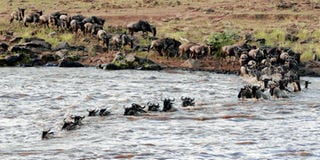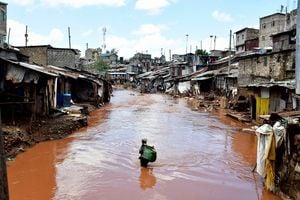The slow death of wildebeest migratory herds

The wildebeests that are usually accompanied by gazelles and zebras relocate annually to the Masai Mara around July before staging another impressive migration back to the Serengeti in November when a dry spell hits the Mara ecosystem. Photo/FILE
What you need to know:
- For decades, the thundering hooves of millions of wildebeest have echoed across the East African savanna, following the rhythm of the seasons, a breathtaking spectacle known as the Great Migration. However, this annual pilgrimage, considered one of nature's greatest wonders, faces an unprecedented threat: human development.
- Highways and fences erected in the name of development have severed ancient pathways and disrupted the delicate balance of ecosystems.
"Who are you and on whose authority are you here?" His voice was loud, authoritative and intimidating. He held a rungu in his hands, the kind that you might use to keep yourself steady when walking, but it can also be quickly converted into a weapon. He was flanked by three other men, armed and coming at us fast.
"Who sent you here?" He yelled. In an instant, we were surrounded by six more men, who had come from various directions. They blended perfectly into the landscape and that is why we did not see them approaching.
We identified ourselves as journalists following a story, but they were not backing down.
"If you do not have authorisation from the Department of Defence, then you need to leave. Now!" They were Kenya Defence Forces, and we had apparently trespassed on their land, never mind the absence of a fence or labels. We left as instructed, and for a moment, we were worried that our story had been ruined. We were just about to record interviews before the soldiers showed up and threatened to delete our footage. In the end, we decided to change locations for the interviews.
We had gone searching for wildebeests.
For decades, the thundering hooves of millions of wildebeest have echoed across the East African savanna, following the rhythm of the seasons, a breathtaking spectacle known as the Great Migration. However, this annual pilgrimage, considered one of nature's greatest wonders, faces an unprecedented threat: human development. Highways and fences erected in the name of development have severed ancient pathways and disrupted the delicate balance of ecosystems.
"I was born in this Kitengela area and back then, we had wildebeests everywhere migrating from Amboseli to Nairobi National Park. That was in the early 1970s. Even into the 1980s, there were lots of wildebeests here. Back then, there was little human activity and development. We did not have construction everywhere and land subdivisions back then," Jeremiah Karoi, a resident of Kitengela and a wildlife enthusiast, narrates.
As Kenya's population grew and its cities expanded, the wilderness shrank. The Maasai Mara, once a haven for wildlife, was hemmed in by fences and concrete. Highways sliced through ancient migration routes, disrupting the flow of life. The grasslands, once vast and unbroken, gave way to fields of crops and settlements. As a result, wildlife migrations that existed in the country no longer exist.

"Today, we have towns that didn't exist before in areas where the animals migrated. Those towns, such as Kitengela, exist in a previously wildlife migratory corridor. So when land subdivisions started and development picked up, wildlife migration was affected," he said.
Dr Joseph Ogutu, a senior statistician and researcher at the University of Hohenheim in Germany, noted that Kenya used to have many wildlife migrations such as the zebra and the Thompson gazelle. They used to migrate between Lake Nakuru and Elementaita to Baringo and Solai. "This migration was actually the most spectacular in Africa, but because of cultivation over the years, it collapsed in 1920," he noted.
When the military officers who had surrounded us inquired about our business in that area, they seemed bothered by Dr Ogutu's presence. They demanded to know why we had brought a researcher with us.
Dr Ogutu has worked with wildlife for nearly 40 years. He is part of a team that has published a study on Africa's collapsing wildlife migrations and what this means for the ecosystem. For Kenya, the consequences are dire. Trapped animals struggle to find enough food, leading to malnourishment and population decline. Additionally, the separation of herds disrupts breeding patterns, further jeopardising future generations.
"When migration collapses, there are many consequences for other wildlife species that depend on it. These migrations support a number of species, including predators and dung beetles. Apart from that, the migrants also transport and distribute a lot of nutrients within the landscape. And when they disappear, a lot of species disappear with them," Dr Ogutu said during the interview.
The study titled Iconic Savanna Mammals Face Genetic Problems due to Fences and Roads, was published in the Nature Communications Journal. It found that new roads, fences and expanding settlements are fragmenting the wildebeest's historic migratory routes in Kenya and across the entire continent, making it increasingly difficult for them to reach vital grazing grounds.
Dr Ogutu revealed that the most recent migration to collapse was in 2015, when wheat farms sprung up in Loita, Narok County, cutting off the area from the Maasai Mara. This saw the number of wildebeests drop by 76 per cent— from 150,000 wildebeests in the 1970s to about 36,500 by 2022.
"The only migration left is the one known as the Great Migration, the Mara-Serengeti migration. And if the Mara was completely separated from the Serengeti, there would be no migration right now. As we speak, the number of wildebeests and zebras from Serengeti to Mara has decreased.
“In the early years when regular monitoring of migration started in 1977, more than one million wildebeests came to Kenya yearly. That number dropped to less than 500,000 in the 90s; nowadays, it's less than 250,000. So, not only has there been a significant drop in the number of animals that come from Serengeti into the Mara, but even the few that come to stay for a much shorter period," Dr Ogutu explained.
He added: "Our calculations show that by 2018, the animals were spending 35 days less in Mara. In total, they normally spend three months. So when you subtract one month, there are only two months left. If this continues, they will be spending less and less time. You can imagine this impact on tourism because tourism in the Mara is mainly driven by migration."
Daniel Katoo, a community elder in Kitengela, noted that the Maasai traditionally live in the wild and with the wildlife. "But I agree that we have curtailed the animals' freedom of movement through haphazard construction. Back in the day, the animals migrated from Nairobi to Serengeti and some went to Amboseli. Animals have no borders. They used to easily travel between countries until humans created borders and fenced them off."
"You also have to consider that we have not expanded the sizes of the national parks or reserves, yet the animal population is also growing," Tony Osiora, a Kajiado resident, said.
As the human population grows, so does the animal population. “But the difference is that while humans can expand their territories, animals can't. So the human expansion then squeezes the animals into very limited space,” he added.
"Two years ago, I was a member of a taskforce that looked at wildlife corridors which existed in the past and how they linked parks and reserves with the animals. We travelled around the country documenting the migratory routes, particularly in Machakos and Kajiado counties. We learnt that those routes no longer exist. Here in Kitengela and Athi River, the migratory route passes from Nairobi National Park through Kitengela town, Export Processing Zone, Namanga Road, Portland Cement and into the conservancies in Machakos County," said Mr Karoi.
Dr Ogutu noted that even in areas where roads are built on prime wildlife habitat, there is no allowance for overpasses or underpasses. “Look at, for example, this case of the road from Athi River to Namanga. When it was upgraded not so long ago, there used to be some wildebeests crossing from Nairobi Park to the Eastern side and Athi-Kaputei plains. But soon after the road was upgraded, it was no longer possible for the animals to continue crossing, and thus the migration collapsed.”
Today, crickets are the only sounds you hear in the Athi-Kaputei area, occasionally interrupted by the sound of passing vehicles. If you were to travel back in time to the 70s, this now-empty grassland would be teeming with elephants, rhinos and zebras. The Athi-Kaputiei wildlife population has dropped by 90.8 per cent from 30,000 wildebeests in the 1970s to 2,750 resident animals by 2021.
Further down the road in Amboseli, the population plummeted from 16,300 animals in the 1970s to just 2,400 wildebeest by 2014 but increased later to 9,162 in 2021.
The researchers said the greatest undoing is the lack of a land use policy. Since the problem has been allowed to go on for so long, it will take a really long time to reverse the damage already caused.
"It's important to note that even though Kenya's wildlife population has dropped by 70 per cent since the 70s and continues to drop, only 8.2 per cent is left is in national reserves of protected areas. The rest are lost among humans and cut off from their herds. So for us to revive the migrations, we must also make spaces available, where they spend during the dry season, such as concentration areas. Then they need the wet season areas where they calve and the corridor connecting these two areas," said Dr Ogutu.
Efforts to mitigate the impact of human development on wildlife migrations are underway, but progress has been slow. Conservationists are advocating for creating wildlife corridors and implementing measures to reduce human-wildlife conflict along migration routes.
"Wildlife is God-given. Tourists pay a lot of money to come and see them here. It is, therefore, our responsibility to ensure that the animals are protected, and that begins by restoring migratory routes," said Mr Karoi.
"But we have to recognise that because of changing land uses, much of the land previously used by wildlife is in private hands now. That's why, in our taskforce, we recommended that the government repossesses this land and compensates those private owners.”
However, the challenges are immense, requiring a delicate balance between the needs of a growing human population and preserving Kenya's natural heritage. As the fate of the wildebeest migration hangs in the balance, the world watches, hoping that humanity will find a way to coexist with the wild creatures that call Kenya home.





